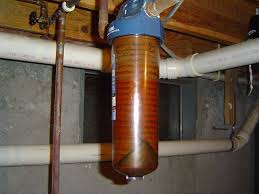Whole House Water Filters can Improve your Entire home’s Water Quality
By Mark J. Donovan
|
|
We regularly take our tap water for granted. We think that it is free from pollutants just because it is coming from a municipal water supply or deep artesian well. Unfortunately this assumption is not always the case. Both municipal water supplies and artesian well water are occasionally found to contain dangerous chemicals, parasite cysts and coliform bacteria. In some cases the water may be safe to drink, but have a funny taste or order. Other times the water may taste and smell fine, however it may contain, iron, rust and sedimentary material.
Besides looking bad at the bottom of a glass of water these types of items may turn your dishwater a rust color and clog your faucets. |
Regardless of your tap water situation it is wise to periodically have your water tested, even if you think it looks and smells fine. Sometimes there can be harmful chemicals in the water that are unnoticeable to the human eye or nose. Fortunately there are a variety of water filters that can address most of the issues found in tap water.
| Water Filter Types
Water filters come in a variety of types and styles to address different types of tap water issues. There are faucet mounted water filters, undersink water filters, countertop water filters, reverse-osmosis water filters, activated carbon filter water filters, ultra-violet water filters, and whole house water filters. What you choose to purchase depends on the results of your water tests and your specific household needs. However, whole house water filters are probably one of the best solutions as they address a wide array of water pollutants and can support the load of an entire home. |
 |
Whole-House Water Filters
Again, the main advantage of whole-house water filters is that they can support the higher flow rates encountered in a home’s main incoming water line and thus can address the needs of the entire home.
They are ideal for removing iron, rust, dirt, sedimentary particles and some heavy metals.
They can also remove a wide range of contaminants that cause the water to taste or smell bad. For example, certain models can address hydrogen sulfide which causes the rotten egg smell in water.
Some models can also support the removal of chlorine, parasite cysts, and volatile organic compounds (VOCs).
| Whole hose filters are installed in series with the main water supply line into the home, and can cost between $40 and $1000. Smaller ones cost between $50 and $100. Typically a plumber is required for the installation of whole house water filter due to the fact that the main water supply line in the home needs to be cut. This said, the above average do it yourself homeowner with a few basic plumbing skills can also do the job.
Whole House Water Filter Maintenance In regards to maintenance, whole house water filter replacement cartridges are fairly inexpensive and are easy to replace. |
|
To change out a whole house water filter cartridge, the process basically involves shutting off the valve on the water filter itself, twisting off the lower base unit, cleaning the base unit, swapping in a new cartridge, reattaching the base unit to the top portion of the filter, and turning the valve back on. It’s that simple.
Whole House Water Filter Buying Considerations
When selecting a whole house water filter, besides checking out what type of containments they can remove, also check the maximum flow rate they can support. Keep in mind, that the more water that can flow through them the less efficient they are at removing pollutants. Smaller size whole house water filters also can reduce the water pressure to your taps, particularly when they begin to get dirty.
Again, before purchasing a water filter, have your water tested first to see what water filter type is right for your specific water needs.
For information on installing a shower pan membrane liner for a ceramic tile shower, see the Shower Pan Membrane Liner Installation eBook from HomeAdditionPlus.com. The Shower Pan Membrane Liner EBook will quickly teach you the step-by-step process for installing the shower pan membrane liner correctly. It includes instructions on framing the shower stall, pouring the pre-slope and shower base mortar, and installing the shower pan membrane liner.
For information on how to tile a custom ceramic tile shower, see the “How to Tile a Custom Ceramic Tile Shower eBook” from HomeAdditionPlus.com. This eBook will quickly provide you with step-by-step instructions on how to measure and install ceramic tile in a shower, including the installation of tile on shower walls, floors and curbs. It provides detailed instructions for every step in the process of tiling a custom ceramic tile shower and is loaded with instructional pictures!
Related Information
Additional Plumbing Resources from Amazon.com
 |
 |
Get Free Bathroom Remodeling Price Quotes with No Obligation!
Fill out our 3-5 minute quick and easy form, and receive a free price quote on a bathroom remodeling project from one of our pre-screened and licensed bathroom remodeling contractors. This process is free and there is no obligation to continue once you receive your bathroom addition price estimate.
